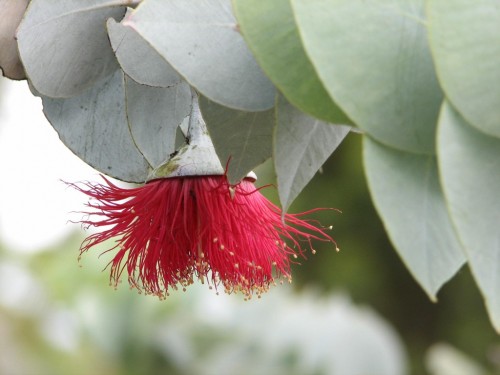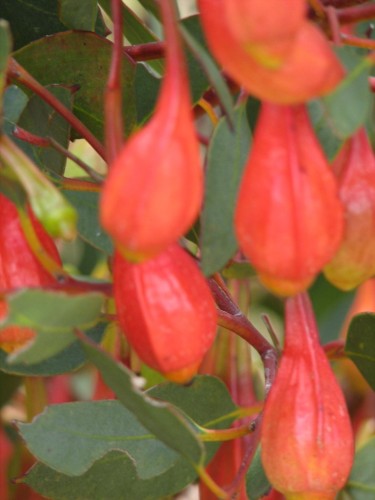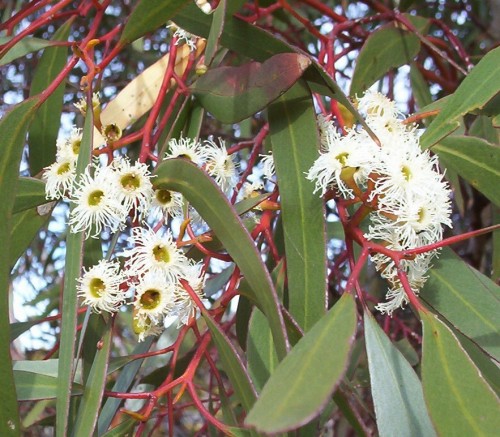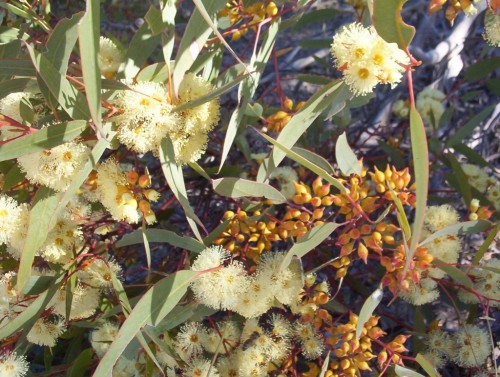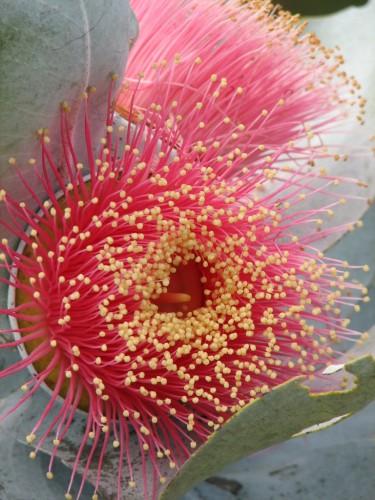Eucalyptus rhodantha (Rose Mallee)
This is a western Australian mallee 2.5-4m high by 3-6m wide. It produces rose red flowers to 7.5cm across. The whole plant is coated in a grey white bloom which really accentuates the colour of the flowers.
It is a plant that requires full sun and a warm climate. The trees can be coppiced once mature and this new growth makes them more useful in a windbreak. This is a rare plant in Western Australia.
Eucalyptus forrestiana (Fuschia Gum)
This tree has attractive gum nuts (capsules) which have the appearance of a fuschia, hence the common name. It is often a tall shrub rather than tree like, being 3-7 metres high by 3-5 metres wide.
It seems to handle the limestone here very well although it is probably in the smaller range so far as size is concerned. It makes a great tree for home gardens. The Honeyeaters love this tree when it is in flower.
Eucalyptus socialis (Red Mallee)
I found this mallee at Lowan Conservation Park when we visited there a couple of months ago. It is a frost hardy and drought tolerant plant.
It is often cultivated because of its ability to grow on a range of sites in dry areas, including shallow limestone. It has a moderate growth rate and flowers at an early age. Its height ranges from 2 to 8 metres. Here it seems to be about 5 metres tall with a lovely wide canopy of foliage, making it a nice shade tree.
Eucalyptus socialis (Red Mallee)
Most of the Eucalypts at Lowan Conservation Park are the mallee, Eucalyptus socialis. I found a good specimen to photograph. I wanted to gather an album of local Eucalypts.
The mallees are great survivors. When top branches are chopped down, or blown down, or burnt by bush fires, they shoot again from buds in the stump, called a lignotuber. The trees can look dead and be covered in new shoots within weeks.
Eucalyptus macrocarpa (Mottlecah)
Today I potted on a potful of seedling Eucalyptus macrocarpa. I just read that they are slightly frost tender. Not sure what to make of that. They certainly seem not to be bothered by temperatures down to -4C. I have had the pot of small seedlings sitting out in the frost this winter. They had their second set of leaves which is why I had to get them into their own pots. The roots were well developed.
This is a rather straggly, shrubby Eucalypt. At the arboretum they are about 3m tall by 4m wide. It appears they can get to 5m tall. There is no sign that they will ever be that tall here. The largest I have seen in our high pH soil is 2m. There are apparently some compact forms around but I think this size is due to the soil. The flowers are about 8cm in diameter and the fruits are very decorative. The nectar feeding birds love this plant. I have used the dried fruit at Christmas time with a candle wedged into the open valves.
The shrubs need to be regularly pruned. The plants grow best in dry areas. They need good drainage and warmth to do well.
I think they would make a great container plant. Apparently in USA they are used as an indoor container plant.
